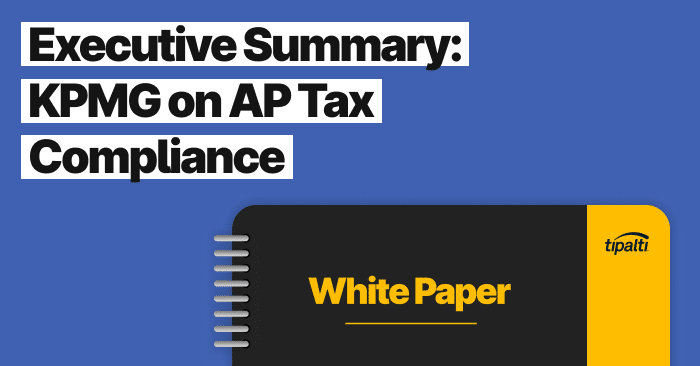
We’ve paired this article with Laurie Hatten-Boyd’s AP Tax Compliance webinar. Get your Executive Summary to find out how FATCA requirements impact organizations with a global supplier base.
Fill out the form to get your free eBook.

Laurie Hatten-Boyd, Principal at KPMG LLP, shared her insights on the impact of US tax compliance rules for companies paying their global suppliers. In this summary of her one-hour webinar, Hatten-Boyd explains how FATCA requirements impact organizations with a global supplier base and the legal and financial penalties they may face for non-compliance. Read the executive summary to get the must-have takeaways from the webinar. – An overview of US tax rules for companies paying global suppliers, including FATCA requirements – Steps your organization can take to avoid legal and financial penalties – How to ensure your payees select the correct form based on their country and corporate structure – How to determine which payees require tax withholding by treaty – The basics around end-of-year 1099/1042-S tax reporting
What is a 1099 Form?
A 1099 form is an IRS tax information return for reporting business-related nonemployee compensation paid, certain other payments, including royalties, miscellaneous information including any backup withholding, and interest and dividends. 1099 tax forms report retirement distributions, government payments like unemployment insurance, barter, real estate, and investment transactions.
The IRS uses different types of 1099 forms for each purpose, with separate instructions for 1099 preparation, including how to fill out 1099 forms, how to file 1099 forms, and where to send 1099 forms by the IRS deadlines.
Types of 1099 Forms
Following are different types of 1099 forms, with the purpose of 1099 forms and some key information on how to prepare 1099 forms. Refer to Internal Revenue 1099 forms Instructions for each type of 1099 due date for electronic filing with the IRS, paper filing with the IRS, and recipient copy distribution. Refer to state income tax agencies for deadlines to file the State copies of form 1099s.
1099-MISC
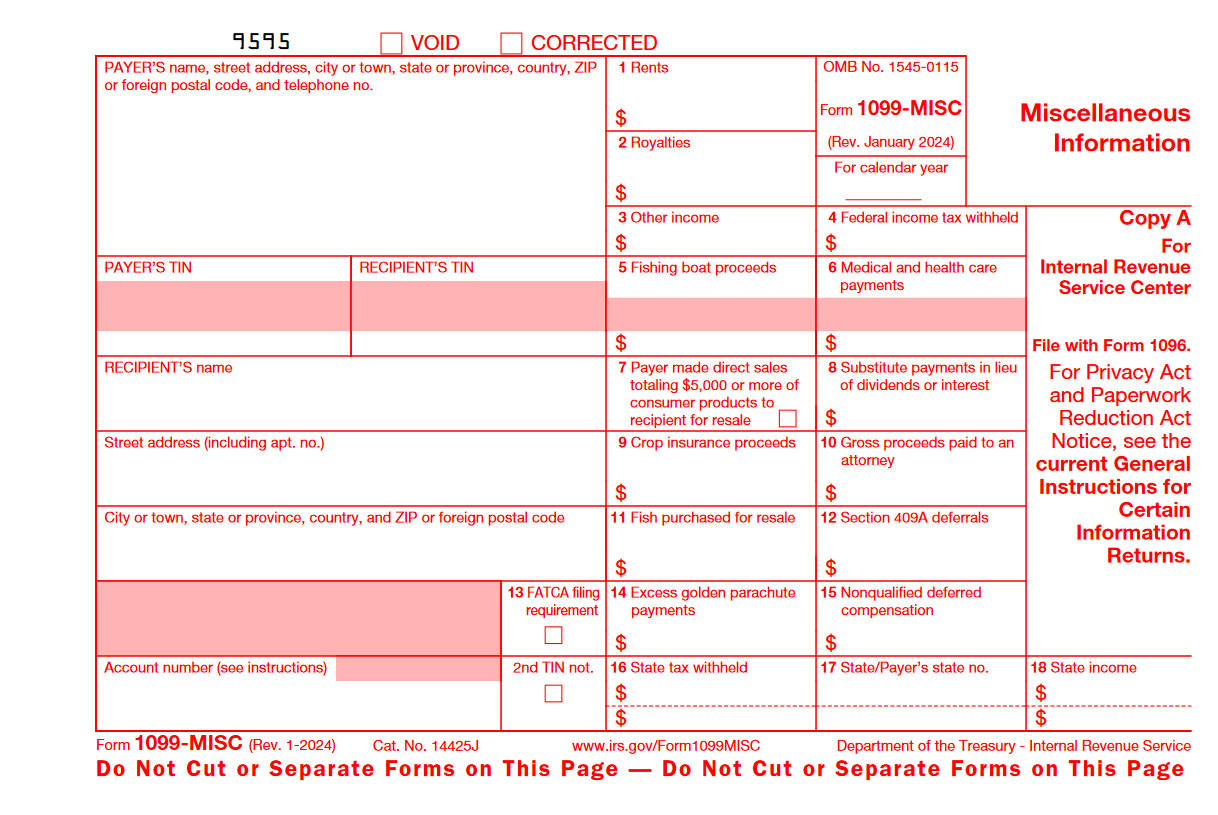
The definition of what Form 1099-MISC (Miscellaneous Information) is, who should receive form 1099-MISC, and a link to 1099-MISC instructions for filling out the form are as follows.
What is IRS Form 1099-MISC?
Form 1099-MISC is used by payers in business to report specified miscellaneous payments other than nonemployee compensation (mostly $600 or more). Form 1099-MISC includes multiple boxes with the information required by the payee to file a U.S. tax return.
1099-MISC (or a different applicable 1099 form, including 1099-NEC) is prepared for any person for which backup withholding for federal income taxes occurs (box 4). 1099-MISC – box 7 (or 1099-NEC – box 2) is a checkbox used for payments of $5,000 or more for direct sales of consumer goods to recipient for resale.
Form 1099-MISC is used to report royalties or broker payments instead of dividends or tax-exempt interest if the amount is at least $10.
Gross proceeds paid to attorneys for claims are still reported on Form 1099-MISC, instead of Form 1099-NEC, without separately reporting the attorney’s fees deducted from the claim proceeds.
Who Should Receive Form 1099-MISC?
U.S. person payees filing a Form W-9 with the vendor should receive Form 1099-MISC for certain miscellaneous business payments received totaling at least $600, excluding nonemployee compensation (which is reported separately by the payer on Form 1099-NEC), and for other specified transactions described in IRS Form 1099-MISC instructions.
1099-MISC Instructions
Refer to IRS 1099-MISC instructions for specific reporting requirements.
1099-NEC

The definition of What is Form 1099-NEC (Nonemployee Compensation), who should receive form 1099-NEC, and a link to 1099-NEC instructions for filling out the form follow.
What is IRS Form 1099-NEC?
Form 1099-NEC is used by payers to report $600 or more paid in nonemployee compensation for business services. The IRS issued Form 1099-NEC for use beginning with tax year 2020 instead of Form 1099-MISC. Payers fill out the form, send it to independent contractors and attorneys paid at least $600 for services in a calendar year, and file a copy with the IRS. Report backup withholding for non-employee compensation in box 4 of Form 1099-NEC.
Who Should Receive Form 1099-NEC?
Independent contractors, like freelancers and real estate agents, in the U.S. (citizens or resident aliens) filing a Form W-9 and other business service providers not on the payroll (receiving Form W-2) should expect to receive Form 1099-NEC from each client exceeding the $600 or more reporting threshold. They should use Form 1099-NEC to file their U.S. federal income tax and state tax returns (usually on Schedule C).
Independent contractors are self-employed small business owners. To receive a 1099-NEC, these contractors need to provide client vendors with their taxpayer identification number (TIN), which is either a social security number (SSN) or employee identification number (EIN) for a U.S. individual or ITIN for a resident (or non-resident) alien. These numbers, other than SSN, are issued by the Internal Revenue Service (IRS).
1099 NEC instructions
Refer to IRS 1099-NEC instructions for specific reporting requirements. 1099-NEC instructions cover which payments need to be reported on the Form 1099-NEC information return and which types of payments are not required. These instructions explain reporting payments to an attorney and note that services payments to non-employees of at least $600 include parts and materials.
1099-INT
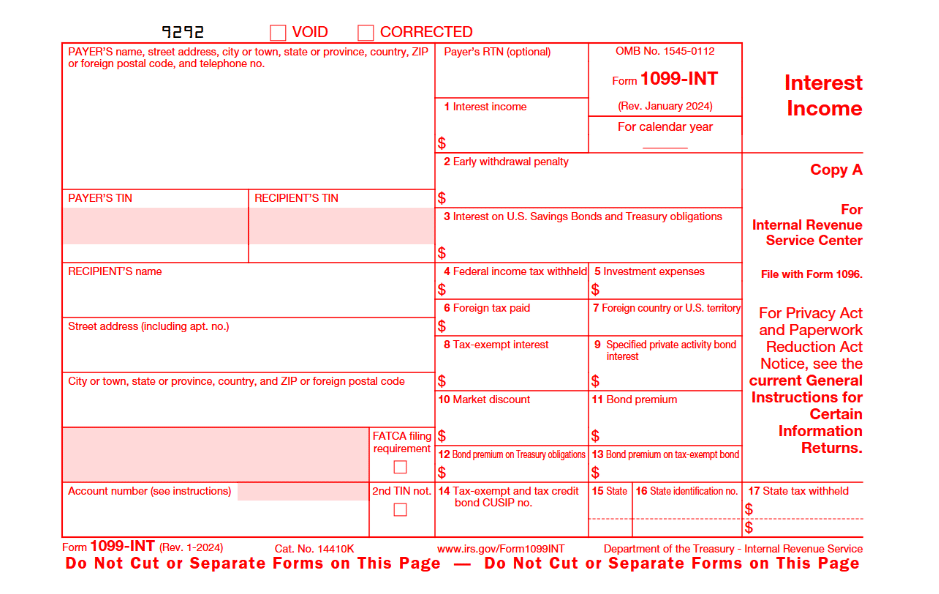
Following is the 1099-INT form definition and who should receive a 1099-INT.
What is IRS Form 1099-INT?
Form 1099-INT is an IRS information return prepared by a financial institution like a bank or brokerage firm to report Interest Income of $10 or more paid to a recipient, foreign taxes withheld and paid on interest income, and any backup withholding of federal income taxes.
According to the IRS 1099-INT Instructions: “Also, include interest of $600 or more paid in the course of your trade or business not meeting the [above] criteria, such as interest on delayed death benefits paid by a life insurance company, interest received with damages, interest on a state or federal income tax refund, or interest attributable to certain notional principal contracts with nonperiodic payments.”
Review the IRS 1099-INT sample form and 1099-INT Instructions for more items to report on form 1099-INT and how to fill out a 1099 tax form for reporting interest income (1099-INT).
Who Should Receive Form 1099-INT?
Holders of an interest-bearing bank account like a savings account or money market account, certificate of deposit (CD), or taxable or non-taxable bond or Treasury obligation with interest paid and recognized in the calendar year should receive form 1099-INT for amounts of $10 or more in the calendar year. Others may be 1099-INT form recipients when other items apply to their situation.
1099-DIV
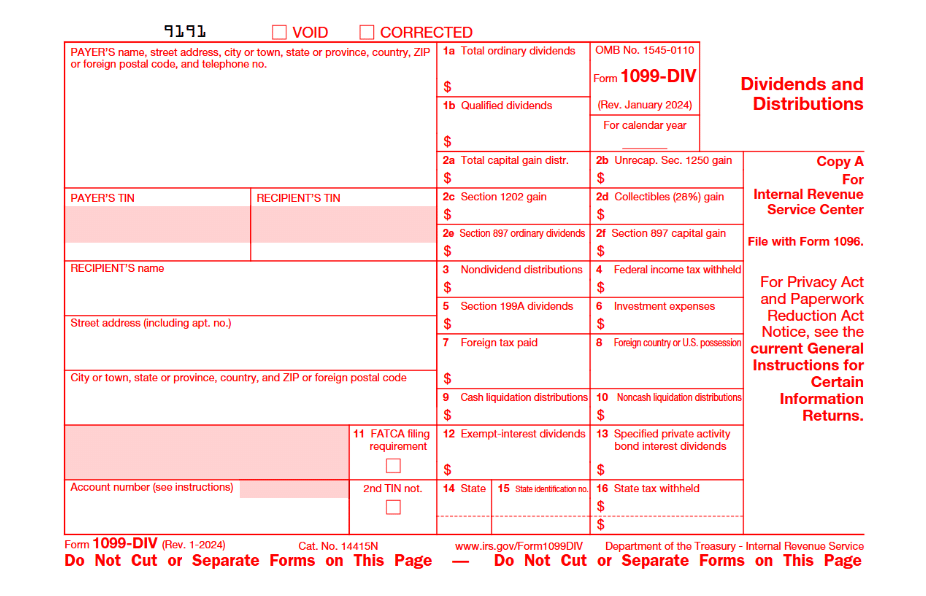
A form 1099-DIV definition, including what is a 1099-DIV form used for, generally who should receive 1099-DIV (refer to IRS Instructions for 1099-DIV), how to do 1099-DIV form distribution to recipients follows.
What is IRS Form 1099-DIV?
Form 1099-DIV is an information return for Dividends and Distributions that financial institutions use to report at least $10 in dividends paid to recipients, capital gain distributions, and certain other investment-related items. Refer to the IRS 1099-DIV form for specific items to report and exceptions where 1099-DIV should not be used. The 1099-DIV instructions also cautions that, in some cases, interest is referred to as dividends, and these items should be reported on form 1099-INT instead.
Who Should Receive Form 1099-DIV?
Recipients of dividend income or capital gain distributions over threshold amounts (and other reported items) should receive a form 1099-DIV.
The form 1099-DIV deadline is shown in the General Instructions for Certain Information Returns. For example, for 2024 calendar year payments, the IRS filing date for Form 1099-DIV is March 31, 2025, for electronic filing or February 28, 2025, for paper filings. The Form 1099-DIV due date for recipient copy distribution is January 31, 2025, except 1099-DIV reporting for trustees and middlemen of WHFITs must be received by these recipients by March 15, 2025.
1099-G
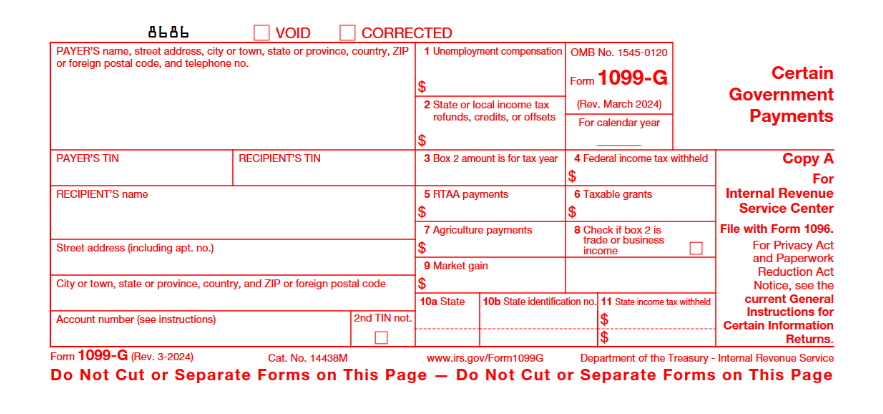
The types of payments used by different levels of government agencies to report government payments on Form 1099-G are indicated below. In addition, who should receive Form 1099-G is discussed in general terms. Refer to IRS form 1099-G instructions for how to complete a 1099 form for required items.
What is IRS Form 1099-G?
Form 1099-G, Certain Government Payments, is used by U.S. government entities at the federal, state, and local levels to report specific types of payments made, including unemployment compensation, and also payments received by governments on a Commodity Credit Corporation (CCC) loan.
Types of government payments reported on a 1099-G IRS information return include:
- Unemployment compensation.
- State or local income tax refunds, credits, or offsets
- Reemployment trade adjustment assistance (RTAA) payments
- Taxable grants
- Agricultural payments
Who Should Receive Form 1099-G?
Recipients of 1099-G form have received specified types of government payments in a calendar year or have had certain types of backup withholding of income taxes that apply to this IRS 1099 form.
1099-K
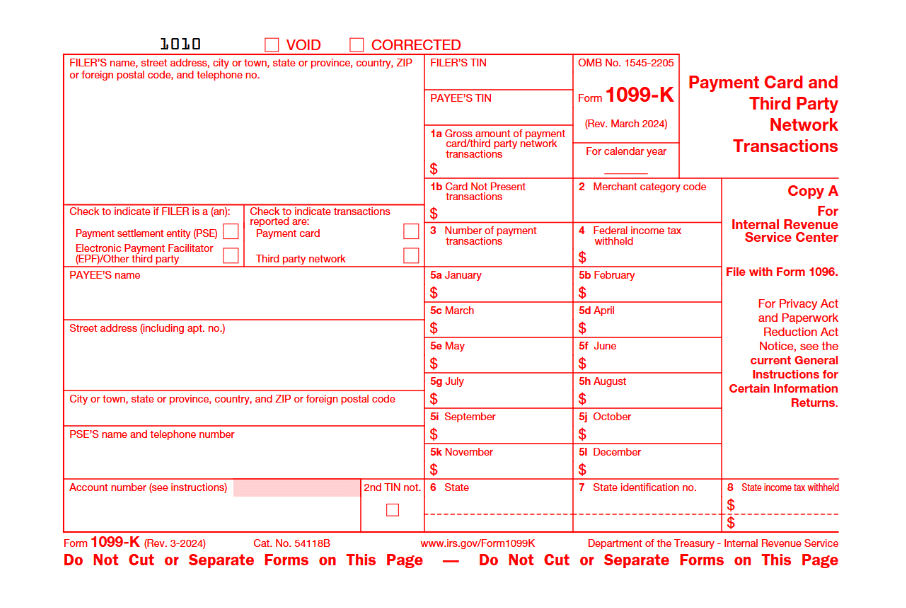
The uses and changes in threshold amounts for Form 1099-K reporting follow.
What is IRS Form 1099-K?
The 1099-K form is used to report payment card and third party network transactions for payments of income-generating transactions through PayPal, Ebay, and similar payment providers.
Form 1099-K, Payment Card and Third Party Network Transactions, has stricter payment reporting threshold requirements, beginning for calendar 2024 payments. The IRS intent of the rule change is to capture payments for goods or services as taxable income that may have been previously unreported by taxpayers when they didn’t receive a 1099 form.
Although it was initially scheduled to begin with the 2022 calendar year, the IRS delayed implementation by two years to the 2024 calendar year’s payments (with a more than $5,000 payments transitional threshold instead of $600 for the 2024 calendar year, more than $2,500 payments threshold for the 2025 calendar year, and more than $600 payments threshold for 2026 calendar and later calendar years) for smoother compliance.
The 2024 and beyond revised IRS rule for completing form 1099-K requires reporting the amount of income-related third party network transactions by third party networks like PayPal, Venmo, or eBay for any number of transactions with cumulative amounts exceeding that calendar year’s payments threshold. The previous 1099-K reporting requirement was more than 200 business transactions with a combined total exceeding $20,000.
This article from the IRS website on Understanding your Form 1099-K has the latest information, verifying the changes effective for calendar 2024 and subsequent year payments and the applicable threshold amounts for each year.
Who Should Receive Form 1099-K?
Recipients of payments (meeting the calendar year threshold) that may constitute revenue or income through third-party networks and payment card platforms should receive Form 1099-K. These recipients should report applicable revenue and income on their income tax returns.
1099-R
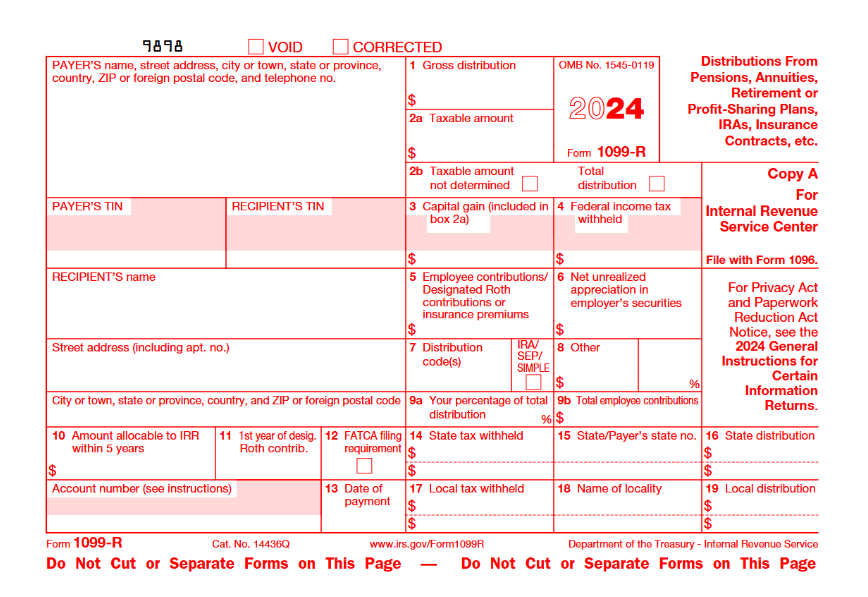
IRS Form 1099-R is for different types of distributions received, including retirement-related, annuities, and insurance contracts.
What is IRS Form 1099-R?
Form 1099-R, Distributions From Pensions, Annuities, Retirement or Profit-Sharing Plans, IRAs, Insurance Contracts, etc., is an information return completed by businesses making distributions of $10 or more (or treated as distributions) to persons who are the payment recipients.
1099-R distributions are made from a recipient’s:
- Profit-sharing or retirement plans
- Any individual retirement arrangements (IRAs)
- Annuities, pensions, insurance contracts, survivor income benefit plans
- Permanent and total disability payments under life insurance contracts
- Charitable gift annuities, etc.
Who Should Receive Form 1099-R?
Recipients of distributions from retirement plans, IRAs, annuities, pensions, and permanent and total disability payments under life insurance contracts (as described in the IRS Form 1099-R Instructions) should receive Form 1099-R.
1099-B
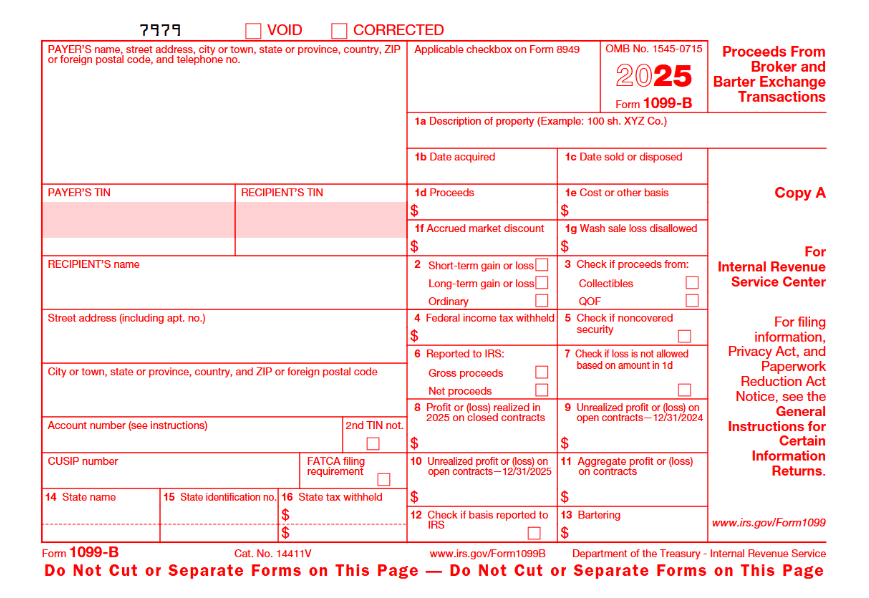
The purpose of Form 1099-B and a description of its recipients follow.
What is IRS Form 1099-B?
Form 1099-B is used to report Proceeds from Broker or Barter Exchange Transactions. A broker or barter exchange uses form 1099-B to report these transactions to the recipient, the IRS, and state governments levying income taxes.
Who Should Receive Form 1099-B?
Investors with investment proceeds from stocks and similar investments sold through a brokerage and traders in bartering transactions should receive a 1099-B.
1099-DA
Form 1099-DA which is proposed for calendar years beginning with 2025 has not yet been finalized by the IRS.
What is IRS Form 1099-DA?
Form 1099–DA is titled Digital Asset Proceeds From Broker Transactions. The purpose of Form 1099-DA, a new 1099 form that will be used beginning in calendar 2025, is to report the sale or exchange of digital assets through broker transactions.
Who Should Receive Form 1099-DA?
Recipients of proceeds from the sale or exchange of digital assets will initially receive Form 1099-DA by the 2026 deadline to report these calendar year 2025 (and subsequent years) transactions on their income tax returns.
1099-S
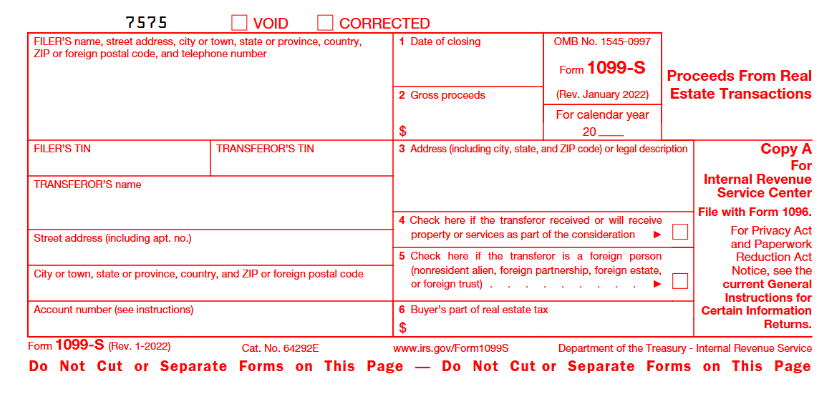
A 1099-S form is used for reporting all types of real estate transaction proceeds. This includes transactions for the sale or exchange of real estate.
What is IRS Form 1099-S?
IRS Form 1099-S is used to report Proceeds from Real Estate Transactions, including the sale or exchange of real estate.
Who Should Receive Form 1099-S?
Recipients of any type of real estate transaction proceeds should receive Form 1099-S.
Who Gets a 1099 Form?
Independent contractors receiving at least $600 in nonemployee compensation for business-related services or miscellaneous income payments and payees receiving $10 or more in royalties, dividends, or interest receive an IRS 1099 form from the payer. Certain non-employees with backup withholding of federal income taxes also get a 1099 form.
We explain who gets a 1099 form MISC and NEC in more detail.
Businesses collect W-9 forms from their suppliers to report calendar year payments of $600 or more on Form 1099-MISC.
Recipients also receive 1099s for other types of income (taxable or non-taxable), including payment card and third-party network transactions, retirement distributions, investment transactions, broker and barter exchange transactions, and real estate transactions from the payer for tax preparation.
Each business payer sends a copy of the required IRS form 1099s to the IRS, state governments with income taxes, and the payee to use the tax documents to prepare their income tax return(s) for tax filing.
The IRS and state government agencies compare 1099 payments and miscellaneous information to a payee’s taxable income on their federal tax or state income tax return.
How to Report 1099 to IRS
Report each type of 1099 form separately to the IRS by batching these forms for all recipients in one transmittal to the IRS. According to Topic 801, the IRS requires eFiing for payers with 10 or more 1099 forms or almost all other types of information returns). Each Copy A of the 1099 forms goes to the IRS.
When payers with less than 10 of these 1099 forms file using paper 1099 forms, they should be accompanied by an official IRS transmittal form, which is Form 1096. IRS Publication 1220 covers specifications for filing electronic returns, including 1099s. The IRS encourages all 1099 filers to file electronically, including those with less than 10 total information returns.
Where do I get 1099 forms? When you plan to file paper 1099 forms with the IRS, order official IRS printable 1099 forms from the IRS that include a scannable Copy A for IRS filing (you can’t download Copy A of these forms from the IRS to print because they aren’t 1099 scannable forms.)
Specialized 1099 tax software (such as Zenwork Tax1099) is used for 1099 preparation and includes electronic 1099 forms. The software offers eFiling functionality to properly report 1099 forms to the IRS and applicable states with income taxes and distribute copies to 1099 payee recipients.
1099 NEC vs 1099 MISC
Forms 1099 NEC vs 1099 MISC are IRS information returns. Payers use Form 1099-NEC to report business-related nonemployee compensation paid to independent contractors and backup withholding of federal income taxes. Payers use Form 1099-MISC to report Miscellaneous Information, certain payments, and any amount of backup withholding of federal income taxes.
When are Form 1099-MISC and Form 1099-NEC Due?
2025 Due Dates for 2024 Year
Forms 1099-NEC are due on January 31, 2025 (if filed either electronically or on paper). For the tax year 2024, Form 1099-MISC is due on February 28th, 2025, if filed on paper, or March 31, 2025, if filed electronically. Payers no longer get an automatic 30-day extension. Payers are required to send the 1099-NEC and 1099-MISC forms to the payee by January 31, 2025 or send the 1099-MISC forms to the payee recipient by February 17, 2025 if amounts are reported in boxes 8 or 10.
Get automatic 1099 eFiling for your company.
With a Zenwork Tax1099 SaaS subscription, Tipalti has optional Zenwork 1099 Tax eFiling integration for automatic eFiling of your 1099-MISC and 1099-NECs, using the last 12 calendar months of Tipalti payments data.
Who Doesn’t Need to Receive a Form 1099-MISC or 1099-NEC?
Generally, C corporations, S Corporations, and LLCs formed as corporations or S Corps don’t need to receive a 1099-NEC or 1099-MISC. On irs.gov, check the 1099-NEC instructions and 1099-MISC instructions for exceptions on when you are required to issue a 1099.
As an exception, attorneys should receive a 1099-NEC for services (except if deducted from a legal claim payment) and a 1099-MISC for legal settlement proceeds paid to attorneys, even if the attorney’s firm is a corporation. And certain healthcare payments should also still be reported for corporations and S-Corps on 1099 forms.
Generally, a 1099 is not required to be issued for international vendors who are foreign vendors.
Individuals living outside the United States who qualify to file an IRS Form W-8BEN as foreign persons/foreign contractors, and don’t perform services in the United States, don’t get a Form 1099-NEC. Form W-8BEN is Certificate of Foreign Status of Beneficial Owner for United States Tax Withholding and Reporting (Individuals).
Beneficial owners in foreign countries complete different forms, depending on whether they perform personal services, which are Form W-8ECI or Form 8233 or Form W-4.
Foreign entities qualified to use Form W-8BEN-E don’t need to get a Form 1099-NEC for services performed or 1099-MISC, which includes interest and dividend income.
Forms W-8BEN and W-8-BEN-E also exempt foreign filers of certain other forms, including intermediaries that file Form W-8-IMY, from receiving a Form 1099-NEC and Form 1099-MISC.
1099 Rules
IRS Instructions for each type of 1099 form include 1099 rules for filing and types of transactions or information to include. Business-related non-employee compensation of at least $600, interest income, dividend income, and royalties payments to recipients of $10+, and any amount of backup withholding of federal income taxes are reported on a Form 1099.
W9 vs 1099
What is the difference between IRS Form W9 vs 1099? Form W9 is completed by independent contractors or other relevant U.S. persons, including citizens and resident aliens, and submitted to payers of business-related services or transactions. The payer uses form W-9 to file 1099-NEC and 1099-MISC forms.
How to Fill Out a 1099 Form
For how to fill out 1099 forms, follow these steps and best practices:
- Read the online IRS instructions for the specific 1099 form and follow links to other important IRS information to understand how to prepare 1099 forms properly, when to withhold income taxes, and how to report withholdings on IRS 1099 tax forms.
- When you have questions about your particular business situation, consult your CPA or tax attorney.
- View images of sample 1099 forms by type.
- Assign a team leader to review the 1099 forms to ensure accuracy and meet the filing and recipient copy distribution deadlines.
- Plan to eFile 1099 forms, as the IRS encourages, even for companies below the 10 total number of information returns threshold.
- If your business meets the requirements for paper 1099 filing and chooses to file paper 1099s, use a 1096 batch transmittal form and order official, scannable forms from the IRS in advance. Refer to W-9 or W-8 forms for recipient name, TIN number, and contact information plus calendar year payments total and withholdings to manually prepare 1099 forms.
- Select AP automation software that:
- collects supplier W-9 or W-8 forms data before the first payment
- validates supplier or payee TIN numbers with IRS TIN matching
- automatically tracks supplier payments for 1099 forms instead of requiring manual spreadsheets and 1099 paperwork to compute form amounts
- calculates any required income tax withholding
- generates a 1099 preparation report for your company’s 1099 easy preparation and filing
- has native integration with optional 1099 eFiling software to use 12 months of imported payment data.
1099 Form FAQs
Who needs a 1099 form?
Non-employee vendors like independent contractors paid for performing business-related services of $600+ or certain types of miscellaneous payments, having any amount of backup tax withholding, receive a 1099 form. The IRS and states with income taxes also receive Form 1099 from the payer. Payees use a 1099 to prepare their tax return(s).
1099 forms are sent by payers to recipients with interest income or dividend income of $10+, participating in investments, barter, and real estate transactions, or receiving retirement distributions, government payments like unemployment insurance, or state and local tax refunds. Third-party networks and credit card companies also issue form 1099-K for gross income totaling the current IRS transaction thresholds or more. Copies of 1099 forms are also sent by the payer to federal and state tax agencies.
How do I get a 1099 form from the IRS?
You can order printed 1099 information return forms from the IRS. Use a transmittal Form 1096 for paper 1099 information returns sent to the IRS. The IRS changed the electronic filing requirement threshold effective for payments beginning January 1, 2024, to 10 or more 1099 forms of all types (from a prior threshold of 250 forms).
Note that the red Copy A of a form 1099 sent to the IRS must be scannable. The IRS will impose a penalty if payers file a non-scannable Form 1099 Copy A with the IRS that’s downloaded from the IRS website.
What is a 1099 form used for?
A 1099 form is used as an information return prepared by a payer to report certain payments made to taxpayers and other required tax information. The payee recipient uses the information to file their federal and state tax return(s). The IRS receives a copy to verify the information on a tax return filed by the taxpayer.
Can I print my own 1099 forms?
You can’t print your own blank 1099 forms from the internet because Copy A of a form 1099 sent to the IRS must be scannable. You must use official IRS forms.
Where can I find 1099 forms? Order each type of printable 1099 form and 1096 Transmittal form you need online from the IRS, allowing enough lead time to receive the forms. For where to purchase 1099 forms, consider buying 1099 forms at an office supply store. Before using them, ensure they include the red, scannable Copy A forms allowable for IRS submission.
For 1099 filings beginning January 1, 2025, for the 2024 calendar year, the requirement threshold for filing 1099s electronically (instead of on paper) was reduced from 250 forms to only 10 forms.
You can use tax software to print 1099s on the official IRS 1099 forms or file 1099 forms electronically.
Is there a new 1099 form?
1099 forms were changed to make separate 1099-NEC and 1099-MISC forms, beginning with the 2020 tax year. In prior years, these 1099 forms were combined. The 1099-NEC and 1099-MISC forms were revised in January 2024, with some box or line changes and a heading space to indicate the prior calendar year for which payments are being reported.
The 1099 form for payers for supplier payments of at least $600 in a calendar year and miscellaneous specified types of reporting is 1099-MISC. The electronic or printable 1099 form independent contractor payers use for calendar year payments over $600 is 1099-NEC. You can report withholding on certain types of 1099 forms, including 1099-MISC and 1099-NEC.
For the calendar year 2025 and subsequent years, reportable starting in 2026, the IRS plans to issue a new 1099 form, 1099-DA, Digital Asset Proceeds From Broker Transactions.
Summary
This article isn’t intended to give you tax or legal advice. Consult your CPA or attorney and read Form 1099-MISC instructions on the Internal Revenue Service website at www.irs.gov. Instead, it is intended to provide basic steps for finding IRS instructions to enable understanding 1099 forms and how to fill out a 1099 tax form.
1099 Forms are IRS information returns used to report information to the IRS and states for multiple purposes. We provide more detailed information in other articles for commonly used IRS forms like 1099-MISC and 1099-NEC.
We also provide articles about Form W-9 and various W-8 forms that global suppliers complete for payers to use in preparing their form 1099s to report calendar year payments. To understand global supplier tax compliance, access the white paper.
